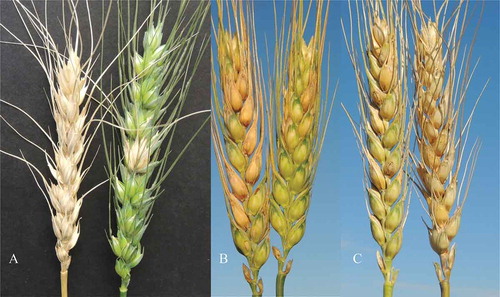Figures & data
Fig. 1 (Colour online) a, Wheat type II resistance. Wheat plant with a high level of type II resistance (right head) usually confines FHB infection to the inoculated spikelet or floret and does not spread to neighbouring spikelets; whereas in a highly susceptible genotype (left head), FHB symptoms spread from the inoculated spikelet to uninoculated neighbouring spikelets until the entire spike is bleached. Both genotypes were inoculated by injecting fusarium spores into a central spikelet of a spike under greenhouse conditions. b, Wheat type I resistance. Under field conditions, the FHB nursery was inoculated by scattering Fusarium infected corn kernels to induce natural infection. The plants with type I resistance show only one or a few infected spikelets (right head), whereas the type I susceptible plant shows multiple independently infected spikelets in a spike (left head). c, Comparison between type I and type II resistance under field conditions. Plant with good type II resistance has lower final disease severity even when multiple florets are infected under heavy disease pressure (left head); whereas plant without type II resistance has entire spike bleached even if only a single spikelet was initially infected (right head).

